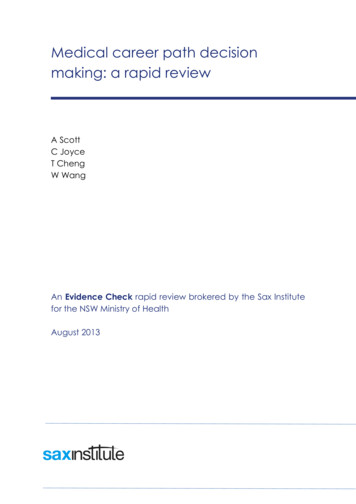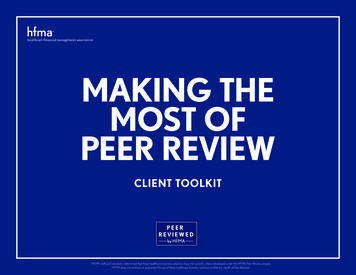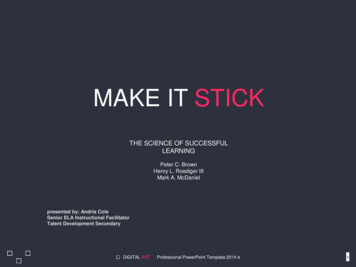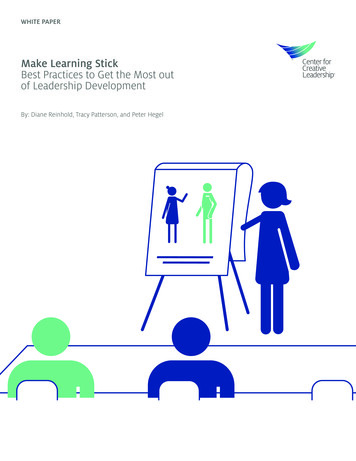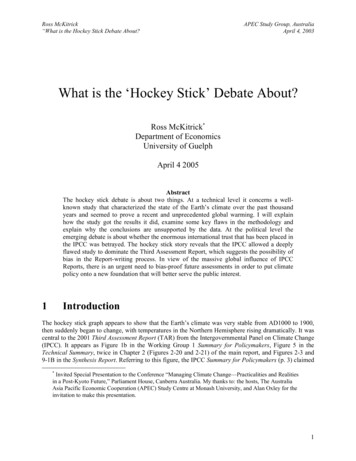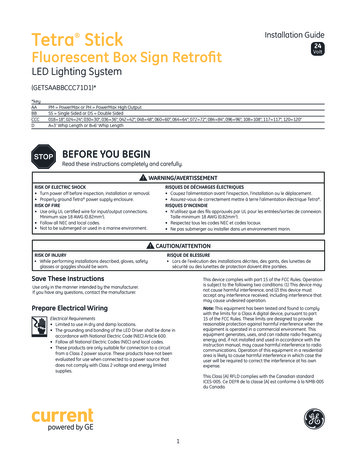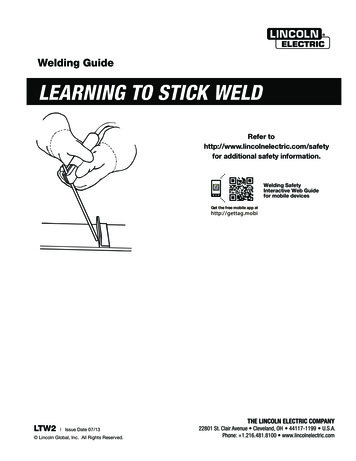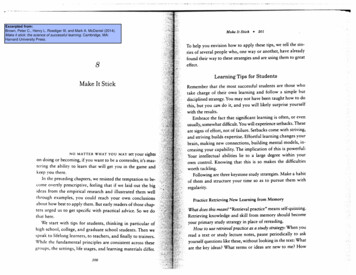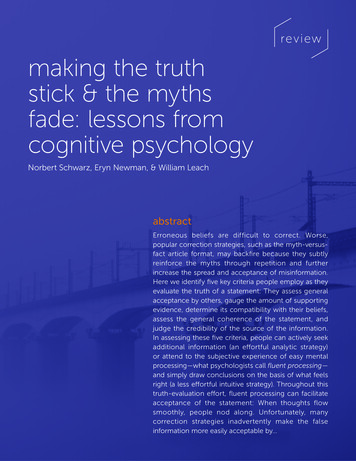
Transcription
reviewmaking the truthstick & the mythsfade: lessons fromcognitive psychologyNorbert Schwarz, Eryn Newman, & William LeachabstractErroneous beliefs are difficult to correct. Worse,popular correction strategies, such as the myth-versusfact article format, may backfire because they subtlyreinforce the myths through repetition and furtherincrease the spread and acceptance of misinformation.Here we identify five key criteria people employ as theyevaluate the truth of a statement: They assess generalacceptance by others, gauge the amount of supportingevidence, determine its compatibility with their beliefs,assess the general coherence of the statement, andjudge the credibility of the source of the information.In assessing these five criteria, people can actively seekadditional information (an effortful analytic strategy)or attend to the subjective experience of easy mentalprocessing—what psychologists call fluent processing—and simply draw conclusions on the basis of what feelsright (a less effortful intuitive strategy). Throughout thistruth-evaluation effort, fluent processing can facilitateacceptance of the statement: When thoughts flowsmoothly, people nod along. Unfortunately, manycorrection strategies inadvertently make the falseinformation more easily acceptable by.
reviewMaking the truth stick & the myths fade:Lessons from cognitive psychologyNorbert Schwarz, Eryn Newman, & William Leachabstract. Erroneous beliefs are difficult to correct. Worse, popularcorrection strategies, such as the myth-versus-fact article format, maybackfire because they subtly reinforce the myths through repetition andfurther increase the spread and acceptance of misinformation. Here weidentify five key criteria people employ as they evaluate the truth of astatement: They assess general acceptance by others, gauge the amountof supporting evidence, determine its compatibility with their beliefs, assessthe general coherence of the statement, and judge the credibility of thesource of the information. In assessing these five criteria, people can activelyseek additional information (an effortful analytic strategy) or attend to thesubjective experience of easy mental processing—what psychologists callfluent processing—and simply draw conclusions on the basis of what feelsright (a less effortful intuitive strategy). Throughout this truth-evaluationeffort, fluent processing can facilitate acceptance of the statement: Whenthoughts flow smoothly, people nod along. Unfortunately, many correctionstrategies inadvertently make the false information more easily acceptableby, for example, repeating it or illustrating it with anecdotes and pictures.This, ironically, increases the likelihood that the false information thecommunicator wanted to debunk will be believed later. A more promisingcorrection strategy is to focus on making the true information as easy toprocess as possible. We review recent research and offer recommendationsfor more effective presentation and correction strategies.Back in 2000, flesh-eating bananas were on theloose and wreaking havoc, according to trendingInternet reports. The story claimed that exported********Schwarz, N., Newman, E., & Leach, W. (2016). Making the truth stick& the myths fade: Lessons from cognitive psychology. BehavioralScience & Policy, 2(1), pp. 85–95.bananas contained necrotizing bacteria that couldinfect consumers after they had eaten the fruit. It wasa hoax, but one with such legs of believability that theCenters for Disease Control and Prevention (CDC) setup a hotline to counter the misinformation and assureconcerned fruit lovers that bananas were perfectly safe.The Los Angeles Times even ran an article explaining thea publication of the behavioral science & policy association85
origin of the myth, noting that the hoax gained tractionbecause a secretary from the University of California,Riverside’s agricultural college forwarded the story tofriends in an e-mail, seemingly giving it the imprimaturof the college. Paradoxically, the efforts by the CDCand the Los Angeles Times to dispel the myth actuallyincreased some people’s acceptance of it, presumablybecause these trustworthy sources had taken the timeand effort to address the “problem.” These corrections likely made the myth more familiar and probably helped the myth and its variants to persist for theentire decade.1No one doubts that the Internet can spread misinformation, but when such falsehoods go beyond bananahoaxes and into the health care realm, they have thepotential to do serious harm. For example, websitesabound that mischaracterize the scientific evidence andmisstate the safety of vaccines, such as that they causeinfection that can be passed on;2 that falsely claim acertain kind of diet can beat back cancer, such as claimsthat drinking red wine can prevent breast cancer;3 andthat overstate preliminary associations between certainfoods and healthful outcomes, such as that eatinggrapefruit burns fat.4 These erroneous statements cancause people to modify their behaviors—perhaps in adetrimental fashion—affecting what they eat and howthey seek medical care.The persistence of the necrotizing banana mythshows that correcting false beliefs is difficult and thatcorrection attempts often fail because addressingmisinformation actually gives it more airtime, increasingits familiarity and making it seem even more believable.5For instance, one of the most frequently used correction strategies, the myth-versus-fact format, can backfire because of repetition of the myth, leaving peopleall the more convinced that their erroneous beliefs arecorrect.6 The simple repetition of a falsehood, even by aquestionable source, can lead people to actually believethe lie. The psychological research showing how peopledetermine whether something is likely to be true hasimportant implications for health communication strategies and can help point to more efficient approachesto disseminating well-established truths in general.Overall, behavioral research shows that often the beststrategy in the fight against misinformation is to paint avivid and easily understood summation of the truthfulmessage one wishes to impart instead of drawingfurther attention to false information.86The Big Five Questions We Ask to Evaluate TruthWhen people encounter a claim, they tend to evaluateits truth by focusing on a limited number of criteria.7Most of the time, they ask themselves at least one of fivequestions (see Table 1).1. Social Consensus: Do Others Believe It?In 1954, the American social psychologist Leon Festinger theorized that when the truth is unclear, peopleoften turn to social consensus as a gauge for what islikely to be correct.8 After all, if many people believea claim, then there is probably something to it. A funexample of this is played out on the popular TV showWho Wants to Be a Millionaire? where, when stumpedfor the correct answer to a question, the contestant maypoll the audience to see if there is a consensus answer.Overall, people are more confident in their beliefsif others share them,9,10 trust their memories moreif others remember an event the same way,11,12 andare more inclined to believe scientific theories if aconsensus among scientists exists.13To verify a statement’s social consensus, peoplemay turn to opinion polls, databases, or other externalresources. Alternatively, they may simply ask themselveshow often they have heard this belief. Chances are thata person is more frequently exposed to widely sharedbeliefs than to beliefs that are held by few others, sofrequency of exposure should be a good gauge for abelief’s popularity. Unfortunately, people are bad attracking how often they have heard something andfrom whom; instead, people rely on whether a messagefeels familiar. This reliance gives small but vocal groupsa great advantage: The more often they repeat theirmessage, the more familiar it feels, leaving the impression that many people share the opinion.For example, Kimberlee Weaver of Virginia Polytechnic Institute and her colleagues showed studyparticipants a group discussion regarding public space.14The discussion presented the opinion that open spacesare desirable because they provide the community withopportunities for outdoor recreation. Participants heardthe opinion either once or thrice, with a crucial difference: In one condition, three different people offeredthe opinion, whereas in the other condition, the sameperson repeated the opinion three times. Not surprisingly, participants thought that the opinion had broaderbehavioral science & policy volume 2 issue 1 2016
Table 1. Five criteria people use for judging truthCriteriaAnalytic evaluationIntuitive evaluationSocial consensus: Do others believe it?Search databases, look for supportingstatistics, or poll a group or audience.Does it feel familiar?Support: Is there much supportingevidence?Look for corroborating evidence inpeer-reviewed scientific articles or newsreports, or use one’s own memory.Is the evidence easy to generate or recall?Consistency: Is it compatible with what Ibelieve?Recall one’s own general knowledge andassess the match or mismatch with newinformation.Does it make me stumble? Is it difficult toprocess, or does it feel right?Coherence: Does it tell a good story?Do the elements of the story logically fittogether?Does the story flow smoothly?Credibility: Does it come from a crediblesource?Is the source an expert? Does the sourcehave a competing interest?Does this source seem familiar andtrustworthy?support when three speakers offered it than when onlyone speaker did. But hearing the same statement threetimes from the same person was almost as influentialas hearing it from three separate speakers, proving thata single repetitive voice can sound like a chorus.14,15These findings also suggest that the frequent repetitionof the same sound bite in TV news or ads may give themessage a familiarity that makes viewers overestimateits popularity. This is also the case on social media,where the same message keeps showing up as friendsand friends of friends like it and repost it, resulting inmany exposures within a network.2. Support: Is There Much Evidence to Substantiate It?When a large body of evidence supports a position,people are likely to trust it and believe that it is true.They can find this evidence through a deliberate searchby looking for evidence in peer-reviewed scientificarticles, reading substantiated news reports, or evencombing their own memories. But people can also takea less taxing, speedier approach by making a judgmenton the basis of how easy it is to retrieve or obtain somepieces of evidence. After all, the more evidence exists,the easier it should be to think of some. Indeed, whenrecalling evidence feels difficult, people conclude thatthere is less of it, regardless of how much informationthey actually remember. In one 1993 study,16 Fritz Strackand Sabine Stepper, then of the University of Mannheimin Germany, asked participants to recall five instances inwhich they behaved very assertively. To induce a feelingof difficulty, some were asked to furrow their eyebrows,an expression often associated with difficult tasks. Whenlater asked how assertive they are, those who had tofurrow their eyebrows judged themselves to be lessassertive than did those who did not have to furrow theirbrows. Even though both groups recalled five examplesof their own assertive behavior, they arrived at differentconclusions when recall felt difficult.In fact, the feeling of difficulty can even overridethe implications of coming up with a larger number ofexamples. In another study,17 participants recalled just afew or many examples of their own assertive behavior.Whereas participants reported that recalling a fewexamples was easy, they reported that recalling manyexamples was difficult. As a result, those who remembered more examples of their own assertiveness subsequently judged themselves to be less assertive than didthose who had to recall only a few examples. The difficulty of bringing many examples to mind underminedthe examples’ influence.These findings have important implications forcorrection strategies. From a rational perspective,thinking of many examples or arguments should bemore persuasive than thinking of only a few. Hence,correction strategies often encourage people to thinkof reasons why an erroneous or potentially erroneous belief may not hold.18 But the more people tryto do so, the harder it feels, leaving them all the moreconvinced that their belief is correct.6 For example, ina publication of the behavioral science & policy association87
a study described in an article published in the Journalof Experimental Psychology; Learning , Memory, andCognition, participants read a short description of ahistoric battle in Nepal.19 Some read that the British armywon the battle, and others read that the Nepal Gurkhaswon the battle. Next, they had to think about how thebattle could have resulted in a different outcome. Somehad to list only two reasons for a different outcome,whereas others had to list 10. Although participants inthe latter group came up with many more reasons thandid those in the former group for why the battle couldhave had a different result, they nevertheless thoughtthat an alternative outcome was less likely. Such findingsillustrate why people are unlikely to believe evidencethat they find difficult to retrieve or generate: A coupleof arguments that readily pop into the head are morecompelling than many arguments that were hard tothink of. As a result, simple and memorable claims havean advantage over considerations of a more complicated notion or reality.3. Consistency: Is It Compatible with What I Believe?People are inclined to believe things that are consistent with their own beliefs and knowledge. 20–22 Oneobvious way to assess belief consistency would be torecall general knowledge and assess its match with newinformation. For example, if you heard someone claimthat vaccinations cause autism, you may check thatclaim against what you already know about vaccinations. But again, reliance on one’s feelings while thinkingabout the new information provides an easier route toassessing consistency. When something is inconsistentwith existing beliefs, people tend to stumble—they takelonger to read it and have trouble processing it. 23–25Moreover, information that is inconsistent with one’sbeliefs produces a negative affective response, as shownin research on cognitive consistency since the 1950s. 26,27Either of these experiences can signal that somethingdoes not feel right, which may prompt more criticalthought and analysis.In contrast, when the new information matchesone’s beliefs, processing is easy, and people tend tonod along. As an example, suppose you are asked,“How many animals of each kind did Moses take on theark?” Most people answer “two” despite knowing thatthe biblical actor was Noah, not Moses28—the biblicallythemed question feels familiar, and people focus on88what they are asked about (how many?) rather thanthe background details (who). But when the questionis printed in a difficult-to-read font that impedes easyprocessing, the words do not flow as smoothly. Nowsomething seems to feel wrong, and more peoplenotice the error embedded in the question. 294. Coherence: Does It Tell a Good Story?When details are presented as part of a narrative andindividual elements fit together in a coherent frame,people are more likely to think it is true.30,31 For instance,in a 1992 article about juror decision making, NancyPennington and Reid Hastie of the University of Colorado described experiments in which they askedvolunteers to render verdicts after reading transcriptsof cases consisting of several witness statements. Theresearchers varied the way information was presented:Either evidence was blocked so that all of the evidence(across several witnesses) regarding motive appearedas a summary, or it was presented more like a story, aswitness narratives. The researchers found that peopletended to believe the witnesses more when the sameevidence was presented in the format of a coherent story.In fact, when asked to remember a story, people oftenremember it in ways that make it more coherent, evenfilling in gaps and changing elements.32 Maryanne Garryof the University of Wellington in New Zealand and hercolleagues had volunteers watch a video of a womanmaking a sandwich. Although participants probablythought they saw the whole video, certain parts of thesandwich-making process were not shown. In a latermemory test, participants confidently but falsely remembered events they had never witnessed in the video.When a story feels coherent, people think that itmakes more sense, and they enjoy reading it more.33,34Coherent stories flow more smoothly and are easier toprocess than incoherent stories with internal contradictions are.30 There are several ways to increase thechances that readers will feel as though they are readinga coherent story. For example, in one line of studies,Jonathan Leavitt and Nicholas Christenfeld of theUniversity of California, San Diego, gave some participants summary information that enabled them to anticipate a story’s ending before they began to read it. Afterreading, those who had the extra information said theyenjoyed the story more—having some prior context lentthe story more coherence and made it easier to follow.behavioral science & policy volume 2 issue 1 2016
5. Credibility: Does It Come from a Credible Source?Not surprisingly, people are more likely to accept information from a credible source than from a less credibleone.35,36 People evaluate the credibility of a source inmany ways, such as by looking at the source’s expertise,past statements, and likely motives. Alternatively, peoplecan again consult their feelings about the source. Whenthey do so, the apparent familiarity of the source loomslarge. Repeatedly seeing a face is enough to increaseperceptions of honesty, sincerity, and general agreement with what that person says.37,38 Even the ease ofpronouncing the speaker’s name influences credibility:When a person’s name is easy to say, people are morelikely to believe what they hear from the person.39 Thus,a source can seem credible simply because the personfeels familiar.An exception to this rule is when people realize thatthe person seems familiar for a bad reason. For example,although the name Adolf Hitler is familiar and easy topronounce, it does not lend credibility. Similarly, familiarity is unlikely to enhance the credibility of a sourcethat is closely identified with a view that one stronglyopposes, as might happen if the source is a politician from an opposing party. (See the sidebar PoliticalMessages from the Other Side.) In these cases, familiaritywith the source comes with additional information thatserves as a warning signal and prompts closer scrutiny.A source also seems more credible when themessage is easy to process. For example, people aremore likely to believe statements when they are madein a familiar and easy-to-understand accent ratherthan a difficult-to-understand one. In a 2010 study, forinstance, Shin Lev-Ari and Boaz Keysar of the Universityof Chicago asked native speakers of American English torate the veracity of trivia statements (such as “A giraffecan go longer without water than a camel can”). Volunteers rated statements recited by native English speakersmore truthful than statements recited by speakers ofaccented English (whose native tongues included Polish,Turkish, Italian, and Korean).40Summary of Truth EvaluationRegardless of which truth criteria people draw on, easilyprocessed information enjoys an advantage over information that is difficult to process: It feels more familiar,widely held, internally consistent, compatible with one’sPolitical Messages from the Other SideMessages from the other side of a political debaterarely change partisan minds. The five truth testsdiscussed in the main text shed some light on why.To begin with, a message from a political opponentcomes from a source that one has already identifiedas being associated with other interests, thus limitingits credibility. Moreover, its content is likely to be atodds with several of one’s beliefs. Accordingly, thinkingof many arguments that support a message fromthe other side is difficult, but coming up with manycounterarguments is easy. In addition, opposing beliefsinterfere with the processing of the information, soarguments will not seem to flow smoothly. This limitsthe perceived coherence of the message—it is justnot a good story. Finally, one’s own social network isunlikely to agree with other-side messages, thus limitingperceived social consensus as well.As a result, messages that contradict a person’s worldviewand advocate opposing positions are unlikely to feel trueand compelling to that person. This effect is not justevidence for the stubbornness of partisans but inherentin how people gauge truth: The dominant truth criteriainherently place beliefs of the other side at a disadvantage.However, the other side’s messages may gain inacceptance as time passes. For example, electioncampaigns expose all citizens to messages that areclosely linked to partisan sources. Yet, as time goes by,the specific source will be forgotten, but the messagemay feel fluent and familiar when it is encountered afterthe campaign is over. That is, although one may reject amessage from the other side at first, the message itselfmay seem more plausible later on, when the originalsource cannot be remembered. At that point, it mayreceive less scrutiny, and people may nod along becauseof the fluency resulting from previous encounters.beliefs, and likely to have come from a credible source.In short, easy processing gives folks an intuitive feelingof believability and helps pass the Big Five major truthcriteria tests outlined above.7 Put simply, when thoughtflows smoothly, people tend to accept them withoutanalyzing them too closely.Alternatively, information that is difficult to process,feels unfamiliar, and makes people stumble is morelikely to trigger critical analysis. When something feelswrong, people pay closer attention, look for more relevant information, and are willing to invest more effortinto figuring out what is likely to be true. People area publication of the behavioral science & policy association89
Fluency: When It Is Easy, It Seems Familiar, and Familiar Feels TrueAny mental act, from reading and hearing to remembering and evaluating, can feel easy or difficult. Material that is easyto process feels fluent, in contrast to material that is difficult to process, which may make the reader stumble. People aresensitive to these feelings but not to where they come from. For example, familiar material is easier to read than unfamiliarmaterial is, but not everything that is easy to read is also familiar.Many things can influence the feeling of fluency. Influences include presentation characteristics, such as print font, colorcontrast, or a speaker’s accent, and content characteristics, such as the complexity and flow of an argument. They also includethe receiver’s expertise and history with the material, such as how often one has seen it before and how long ago one saw it.When any of these factors make processing easy, they increase the likelihood that a message is accepted as true. Hence,people are more likely to consider a statement true when it is presented, for example, in high color contrast, in a more simplefont or in a rhyming form.A,BMore likely to be judged true:Less likely to be judged true:Orsono is a city in ChileOrsono is a city in ChileWoes unite foesOrsono is a city in ChileOrsono is city in ChileWoes unite enemiesA. Reber, R., & Schwarz, N. (1999). Effects of perceptual fluency on judgments of truth. Consciousness and Cognition, 8, 338–342.B. McGlone, M. S., & Tofighbakhsh, J. (2000). Birds of a feather flock conjointly (?): Rhyme as reason in aphorisms. Psychological Science, 11,424–428.also more likely to notice misleading questions and tocritically examine their own beliefs.7,29,41 If their critical analysis reveals something faulty, they will rejectthe message. But if the arguments hold up to scrutiny,a message that initially felt wrong may end up beingpersuasive. Nevertheless, in most cases, recipientswill conclude that a message that feels wrong is notcompelling. After all, at first glance, it did not meet theBig Five truth criteria discussed above.Repeating False Information: A Bad IdeaThe reviewed research sheds light on why some correction strategies may unintentionally cement the ideasthey are trying to correct: When a correction attemptincreases the ease with which the false claim can beprocessed, it also increases the odds that the falseclaim feels true when it is encountered again at a laterpoint in time.Repetition Increases AcceptanceThe popular strategy of juxtaposing myths and factsnecessarily involves a repetition of the false claims90(or myths) in order to confront them with the facts. Agrowing number of studies show that this strategy canhave unintended consequences: increasing the acceptance of false beliefs, spreading them to new segmentsof the population, and creating the perception thatthe false beliefs are widely shared. For example, in a2005 study,42 Ian Skurnik of the University of Torontoand his colleagues had participants view health- relatedstatements. They told them which ones were trueand which were false. When participants were testedimmediately, they were able to recall this informationfrom memory and could distinguish fact from fiction.But 3 days later, after their memories had a chance tofade, participants were more likely to think that anystatement they had seen was true, whether it had beenpresented as true or false. Moreover, the acceptanceof false statements increased with the number ofwarnings: Participants who had been told thrice thata statement was false were more likely to accept it astrue than were those who had only been told once.Older participants were particularly vulnerable to thisbias, presumably because their poorer memory madeit harder to remember the details of what they hadheard earlier.behavioral science & policy volume 2 issue 1 2016
Myth-Busting Can Convey ControversyParticipants who had been told thrice that astatement was false were more likely to accept it astrue than were those who had only been told once.Startlingly, it takes neither 3 days nor old age for sucha paradoxical effect to occur. When undergraduatesviewed a myths-and-facts flyer about the flu taken fromthe CDC website, they remembered some myths asfacts after only 30 minutes.6 Moreover, despite the flyer’spromotion of the flu vaccine for their age group, participants who had read the myths-and-facts flyer reportedlower intentions to get a flu vaccination than did participants who read only the facts. Worse, their reportedintentions to get vaccinated were even lower than thoseof control participants who had not been exposed toany message about the flu. Apparently, realizing theremight be some controversy about the issue was sufficient to undermine healthy intentions.The popular myth-versus-fact formats also convey theimpression that a significant number of people hold adifferent position or positions on an issue, or else therewould be no reason to juxtapose myths and facts. Soalthough the myth-versus-fact format may increasereadership and engagement, it also can make a topicseem controversial and render the truth unclear. It tellspeople that either side could be right and can make avocal minority seem larger than it is. People with limitedexpertise in an area are therefore likely to defer judgment and hesitate to take sides. This is particularly likelyin scientific controversies, where the facts are difficultfor the public to evaluate, as is the case with certaindietary approaches or health treatments4 as well as forclimate change.13,46 The strategy of emphasizing controversy to engage readers is problematic when the actualfacts have been well demonstrated, because it undermines the credibility of the facts and facilitates overestimates of the disagreement.Repetition Spreads Misinformation to New AudiencesAnecdotes and Photographs Reinforce the MessageMyths typically take root in a small segment of thepopulation, yet sometimes a myth breaks free andspreads to larger audiences. Ironically, the cause of thespread may be education campaigns. Although onemay hope that the clear juxtaposition of myth and factteaches the new audience what’s right and wrong andinoculates them against later misinformation, this is notalways the case. Instead, a well-intentioned informationcampaign may have the unfortunate effect of spreadingfalse beliefs to a broader population.The flesh-eating bananas rumor is an example. Itmoved from the fringes of the Internet to mainstreammedia after the CDC published its correction, whichwas picked up by the Los Angeles Times. After a while,people misremembered the sources of the correctionas the sources of the false information itself, resultingin the impression that flesh-eating bananas are a realproblem.43 This retrospective attribution of a myth to amore credible source goes beyond the more commonobservation that messages initially seen as unconvincingbecause they come from an untrustworthy source canexert an influence later on, once their source is forgotten(a phenomenon known as the sleeper effect).44,45Anecdotes and photos serve several communicativegoals—they capture attention, boost comprehension,and enhance the readability of associated text.47–49 Thismakes the content easier to imagine, which can artificially boost its perceived truth.50Anecdotes promote understanding because theylink new information with prior knowledge and evokevivid pictures in people’s minds. For these reasons, theycan have powerful effects on people’s beliefs, leadingthem to ignore available s
Making the truth stick & the myths fade: Lessons from cognitive psychology Norbert Schwarz, Eryn Newman, & William Leach abstract. Erroneous beliefs are difficult to correct. Worse, popular correction strategies, such as the myth-versus-fact article format, may backfire becau

